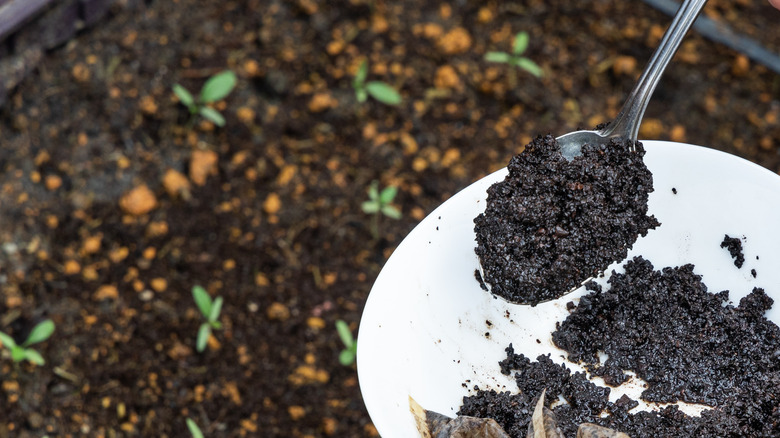The Surprising Benefits of Coffee Grounds in Gardening
As gardeners seek innovative ways to reduce waste and create a more sustainable gardening practice, using coffee grounds in the garden has emerged as a valuable technique. By repurposing coffee waste into a natural fertilizer, gardeners can improve soil health, increase plant growth, and even reduce their environmental footprint. Coffee grounds used in garden have been shown to provide essential nutrients, improve soil structure, and repel pests, making them an attractive alternative to synthetic fertilizers. With the average American consuming over 2 cups of coffee per day, the potential for coffee ground waste is staggering. By incorporating coffee grounds into their gardening routine, gardeners can make a significant impact on reducing waste and creating a more sustainable future.
How to Use Coffee Grounds as a Natural Fertilizer
To reap the benefits of coffee grounds in gardening, it’s essential to incorporate them into your gardening routine correctly. Here’s a step-by-step guide to get you started:
First, collect and dry your coffee grounds. This will help prevent mold and bacterial growth. Next, mix 1 part coffee grounds with 10 parts soil or compost. This ratio ensures the coffee grounds don’t overpower the soil. For a more targeted approach, apply a 1-inch layer of coffee grounds around the base of your plants, working it into the soil gently.
Timing is also crucial. Apply coffee grounds in the spring or fall when plants are actively growing. Avoid using coffee grounds during extreme weather conditions, such as heavy rainfall or drought, as this can lead to nutrient leaching or waterlogging.
When using coffee grounds as a natural fertilizer, it’s essential to monitor your soil’s pH levels. Coffee grounds have a pH level of around 6.5, which can affect the overall soil pH. Regularly test your soil to ensure it remains within the optimal range for your plants.
By following these simple steps, you can unlock the full potential of coffee grounds used in garden and create a nutrient-rich soil environment that promotes healthy plant growth.
The Science Behind Coffee Grounds’ Nutrient-Rich Properties
Coffee grounds are a nutrient-rich organic matter that provides essential elements for plant growth. The chemical composition of coffee grounds is primarily made up of carbon, oxygen, and nitrogen, with smaller amounts of phosphorus, potassium, and other micronutrients. When added to the soil, coffee grounds release these nutrients slowly, providing a steady supply of nourishment for plants.
The high nitrogen content in coffee grounds, approximately 2.5%, makes them an ideal natural fertilizer for plants that thrive in nitrogen-rich environments. Additionally, coffee grounds contain phosphorus, which promotes root development, flower and fruit production, and overall plant health. The potassium content in coffee grounds helps regulate water balance, promotes healthy cell growth, and enhances disease resistance in plants.
The nutrient-rich properties of coffee grounds used in garden make them an attractive alternative to synthetic fertilizers. By incorporating coffee grounds into their gardening routine, gardeners can create a nutrient-dense soil environment that supports healthy plant growth and development. As plants absorb the nutrients from the coffee grounds, they become more resilient to disease, pests, and environmental stressors, leading to a more bountiful harvest.
Coffee Grounds and Soil Structure: A Perfect Pairing
One of the most significant advantages of using coffee grounds in garden is their impact on soil structure. When added to the soil, coffee grounds improve drainage, aeration, and water retention, creating an ideal environment for healthy plant growth. The porous nature of coffee grounds allows water to penetrate deeper into the soil, reducing runoff and erosion. This, in turn, enables plants to access water and nutrients more efficiently, leading to stronger root systems and more vigorous growth.
The improved aeration provided by coffee grounds also promotes beneficial microbial activity, which breaks down organic matter and releases nutrients for plants to absorb. Additionally, the increased water retention capacity of coffee grounds-amended soil reduces the need for frequent watering, making it an attractive option for water-conscious gardeners.
The benefits of coffee grounds on soil structure are particularly evident in heavy clay or sandy soils, which often struggle with drainage and water retention. By incorporating coffee grounds into these soils, gardeners can create a more balanced and fertile growing medium that supports healthy plant growth. As a result, plants grown in coffee grounds-amended soil tend to be more resilient to environmental stressors and require fewer fertilizers and pesticides, making it a sustainable and eco-friendly gardening practice.
Which Plants Benefit Most from Coffee Grounds?
While coffee grounds can benefit a wide range of plants, some species respond particularly well to the nutrient-rich properties of coffee grounds used in garden. Tomatoes, for instance, thrive in coffee grounds-amended soil, as the increased nitrogen and phosphorus levels promote healthy fruit production and root development. Peppers, too, benefit from the improved soil structure and water retention provided by coffee grounds, leading to more vigorous growth and higher yields.
Azaleas, rhododendrons, and other acid-loving plants also appreciate the acidic pH of coffee grounds, which helps to create an ideal growing environment. Additionally, coffee grounds can improve the growth and flowering of roses, hydrangeas, and other flowering plants by providing essential micronutrients and improving soil drainage.
Successful coffee ground-based gardening projects have also been reported with carrots, radishes, and other root vegetables, which benefit from the improved soil structure and aeration provided by coffee grounds. Even houseplants like ferns, peace lilies, and spider plants can thrive when coffee grounds are added to their potting mix, as the nutrients and improved drainage promote healthy growth and development.
By understanding which plants benefit most from coffee grounds, gardeners can strategically incorporate this natural fertilizer into their gardening routine, creating a more diverse and thriving garden ecosystem.
Common Mistakes to Avoid When Using Coffee Grounds in Your Garden
While coffee grounds can be a valuable addition to any garden, there are some common mistakes to avoid when using them. One of the most critical errors is over-application, which can lead to an overabundance of nitrogen in the soil, causing more harm than good to plants. It’s essential to start with a small amount, such as a 1:10 ratio of coffee grounds to soil, and gradually increase as needed.
Inadequate mixing is another mistake to avoid. Coffee grounds should be thoroughly incorporated into the soil to ensure even distribution of nutrients. Simply sprinkling coffee grounds on the surface of the soil can lead to uneven growth and reduced effectiveness.
Neglecting pH levels is also a common mistake. Coffee grounds have a pH level of around 6.5, which can affect the overall pH of the soil. Gardeners should monitor their soil’s pH levels and adjust accordingly to ensure optimal growing conditions.
Additionally, gardeners should be aware of the type of coffee grounds they are using. Fresh coffee grounds can be too hot for some plants, causing burning or scorching. It’s recommended to use aged or composted coffee grounds to avoid this issue.
By being aware of these common mistakes, gardeners can avoid potential pitfalls and unlock the full potential of coffee grounds used in garden. With proper application, mixing, and pH management, coffee grounds can become a valuable tool in any gardener’s arsenal.
Combining Coffee Grounds with Other Natural Amendments
While coffee grounds are a valuable addition to any garden, they can be even more effective when combined with other natural amendments. By blending coffee grounds with compost, manure, or worm castings, gardeners can create a nutrient-rich soil blend that provides a broad spectrum of benefits for plants.
Compost, for example, adds a diverse range of microorganisms to the soil, which work in tandem with the nutrients provided by coffee grounds to create a thriving ecosystem. Manure, on the other hand, provides a slow release of nutrients that can be especially beneficial for plants with longer growth cycles. Worm castings, also known as vermicompost, are rich in micronutrients and can help to improve soil structure and water retention.
When combining coffee grounds with other natural amendments, it’s essential to consider the specific needs of the plants being grown. For example, a blend of coffee grounds and compost may be ideal for vegetables and fruits, while a mix of coffee grounds and worm castings may be better suited for flowering plants. By experimenting with different combinations, gardeners can create a customized soil blend that meets the unique needs of their garden.
Using coffee grounds in combination with other natural amendments can also help to reduce waste and promote sustainable gardening practices. By repurposing coffee grounds and other organic materials, gardeners can reduce their environmental impact and create a more closed-loop system. This approach not only benefits the garden but also contributes to a healthier planet.
By incorporating coffee grounds into a broader natural amendment strategy, gardeners can unlock the full potential of coffee ground used in garden and create a thriving, sustainable garden ecosystem.
Conclusion: Unlocking the Full Potential of Coffee Grounds in Your Garden
In conclusion, using coffee grounds in gardening is a simple yet effective way to promote sustainable gardening practices and improve plant growth. By understanding the benefits of coffee grounds, from their nutrient-rich properties to their impact on soil structure, gardeners can unlock the full potential of coffee ground used in garden and create a thriving ecosystem.
Whether used as a natural fertilizer, a soil amendment, or in combination with other natural materials, coffee grounds offer a versatile and environmentally friendly solution for gardeners. By experimenting with different methods and applications, gardeners can find the perfect approach for their unique garden needs.
As the importance of sustainable gardening practices continues to grow, the use of coffee grounds in gardening is poised to play an increasingly important role. By embracing this innovative approach, gardeners can not only improve the health and productivity of their gardens but also contribute to a more environmentally conscious future.
So why not give it a try? Start collecting those coffee grounds and get creative with your gardening routine. With a little experimentation and patience, you can unlock the full potential of coffee ground used in garden and enjoy a more vibrant, thriving, and sustainable garden.







